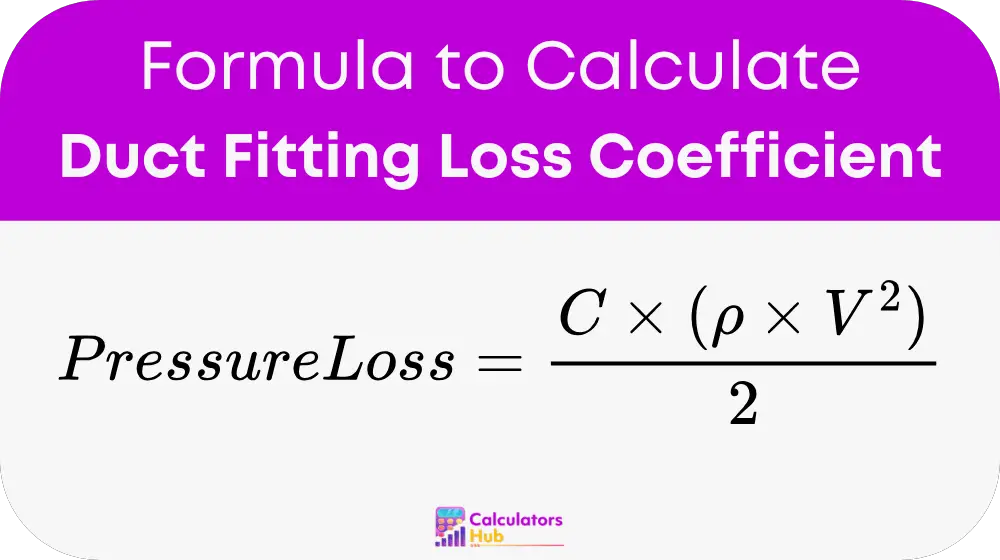The Duct Fitting Loss Coefficient Calculator finds the pressure loss caused by fittings in a duct system. Fittings—like bends, splits, or expansions—make air work harder to flow, dropping pressure. You use this calculator to measure that drop, ensuring your system runs efficiently. It’s great for real-life decisions, like designing ventilation, picking fans, or saving energy.
This tool takes the fitting type, air speed, and air density to give you a clear number. It’s reliable for important tasks, like keeping air quality good or cutting costs. Want to know how it’s calculated? Let’s look at the formula next.
Formula for Duct Fitting Loss Coefficient
The pressure loss from duct fittings uses this formula:

Where:
- Pressure Loss is measured in Pascals (Pa) or inches of water column (in. w.c.)
- C is the loss coefficient (no units)
- ρ is the air density (kg/m³, usually 1.2 for standard air)
- V is the air velocity (m/s)
Loss Coefficients for Common Fittings
Each fitting has its own C value:
Elbows
- 90° smooth radius elbow: C = 0.15-0.25
- 90° square elbow: C = 1.0-1.3
- 90° square elbow with turning vanes: C = 0.15-0.2
- 45° smooth radius elbow: C = 0.1-0.15
Transitions
- Gradual expansion (angle < 15°): C = 0.1-0.3
- Sudden expansion: C = (1 - A₁/A₂)² (A₁ and A₂ are cross-sectional areas)
- Gradual contraction (angle < 15°): C = 0.04-0.08
- Sudden contraction: C = 0.4-0.5
Junctions
- Branch entry: C = 0.25-1.0
- Wye: C = 0.15-0.4
Other
- Entry from free space: C = 0.5-1.0
- Exit to free space: C = 1.0
Combined Loss Coefficient
For multiple fittings:
Total C = C₁ + C₂ + C₃ + ... + Cₙ
These values come from HVAC engineering standards. Now, let’s make it easier with a table.
Quick Reference Table for Pressure Loss
Why calculate every time? This table shows pressure loss for common fittings at 5 m/s velocity and 1.2 kg/m³ air density. It’s a fast way to check without math.
| Fitting Type | C Value | Pressure Loss (Pa) |
|---|---|---|
| 90° Smooth Elbow | 0.20 | 15 |
| 90° Square Elbow | 1.2 | 90 |
| Gradual Expansion | 0.2 | 15 |
| Sudden Contraction | 0.45 | 33.75 |
| Branch Entry | 0.5 | 37.5 |
How to Use the Table
- Pick your fitting and C value.
- Check the pressure loss at 5 m/s.
- Adjust for different speeds using the formula.
This table helps with searches like “pressure loss 90-degree elbow.” For custom setups, use the formula. Next, let’s try an example.
Example: Calculating Pressure Loss
Suppose you have a 90° square elbow in a duct. The air moves at 6 m/s, and the air density is 1.2 kg/m³. You want to know the pressure loss. Here’s how to do it:
- Choose the C value:
90° square elbow = 1.2 - Plug into the formula:
Pressure Loss = C × (ρ × V²)/2
Pressure Loss = 1.2 × (1.2 × 6²)/2 - Calculate step-by-step:
- 6² = 36
- 1.2 × 36 = 43.2
- 43.2 ÷ 2 = 21.6
- 1.2 × 21.6 = 25.92 Pa
So, the pressure loss is about 25.92 Pascals. This fits engineering data and helps you plan your system.
Most Common FAQs
Pressure loss affects how well air flows—too much loss means you need a stronger fan or bigger ducts.
Yes, as long as you know the fitting type, air speed, and density, it works for any setup.
Add the C values together for a total, then use the formula once for the combined loss.